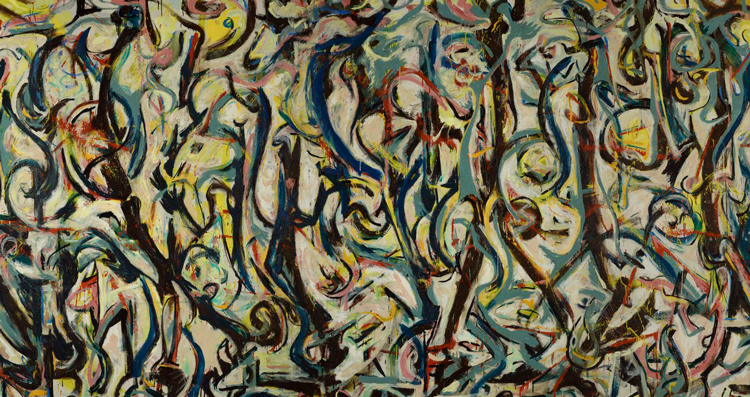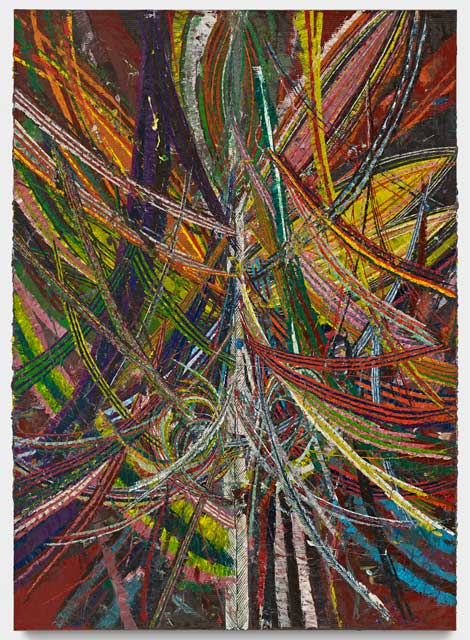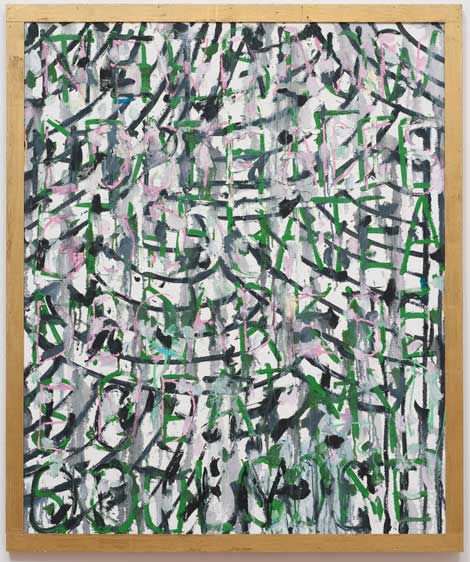IN THE BEGINNING
There is something about abstraction. The concept of the non-pictorial, non-mimistic image is unique in art, and in the world. Sometimes it seems to me that there is abstract art, and then there is everything else. This is what Ad Reinhardt meant when he wrote that “Art is art-as-art and everything else is everything else.” It is an intriguing concept. Everything in the world seems to have a purpose or meaning, and abstract art defies the pragmatic, the descriptive, the narrative. It is a form of art that requires no justification or interpretation, just as a sunset or star-filled sky require neither of these. Indeed, I find it impossible to justify the creation of abstract art in today’s world, but am compelled to make it as an artist myself and seek it out nonetheless. The transcendent experience it can provide is something I continue to crave.
In the 21st century, abstraction has a fascinating relationship to the art world, and to the world at large. On the one hand, the art world tends to look at abstract painting as being traditional, even old-fashioned, which it is; when the paint was wet on those early Kandinskys, it was practically in the Victorian era, the space age still half a century away. On the other hand, to the public at large, it is still radical and mysterious—most people really don’t know what to make of an abstract artwork. Many regard it with mistrust, as if it were a hoax that the entire art world has been fooled by. Or they simply dislike it, as people tend to dislike things they do not understand. This dichotomy characterizes the captivating position currently occupied by abstract art.
Last year witnessed a profusion of exhibitions that demonstrated the continued vitality of abstract painting, as well as many that unfortunately show its continued potential as a vehicle to produce attractive wall decoration. As Simon Schama said about Rothko, he knew the difference between pretty and powerful, and powerful was what he wanted. It really comes down to the artist’s desire and ability to move abstract painting forward. This requires a very sophisticated understanding of abstraction’s history, and much time spent studying historical abstract painting in museums.

- Mark Grotjahn, Untitled (Circus No. 8 Face 44.26), 2013, photography by
Douglas Parker, courtesy of the artist and Blum & Poe, © Mark Grotjahn.
Fortunately, here in Los Angeles we have two superb collections available, the chronology at LACMA that begins with Post-Impressionism—which is really where abstraction originates—and runs through the 1970s, and the collection at MOCA, which is mainly Abstract Expressionism. Together, these two stellar collections provide the inimitable historical context that is mandatory for the aspiring abstract painter; they should be studied carefully and often. As Frank Stella wrote in his book Working Space, there is no substitute for looking at the actual works, you have to be able to go up to the surface and see how the artist put the paint on.
Surprisingly, one of 2014’s most impressive historical abstract painting exhibitions was at the Getty Center. After two years of restoration, Jackson Pollock’s Mural from 1943 was unveiled, along with an exhibit documenting the conservator’s efforts. The painting looked stunning; I could easily say that it was the most powerful abstract painting I have seen in years, the most visually inventive and compelling one. It was reportedly inspired by Pollock’s witnessing of a mustang stampede during his teenage years in the west, but many historians see it as a group of abstracted, attenuated stick figures that appear and disappear amongst the meaty brushstrokes that form a pulsating field across the canvas. What is it that makes the work so much stronger than most current abstract painting? For one thing, it retains a reference to the world. Contrary to the theories of Clement Greenberg, who championed Pollock’s art, abstraction seemed to lose something in the years following Mural, when it became more non-referential. Greenberg’s theories about the autonomy of painting sound great as ideas, but in practice they have not produced the most compelling work. So the continued perception that Mural achieved a high standard of abstract painting makes it serve as a benchmark with which to evaluate current work.
IN THE MUSEUMS
One of the most ambitious recent surveys of contemporary abstraction was “Variations: Conversations in and Around Abstract Painting” at LACMA. The exhibition featured the work of 29 artists whose “work reflects the language and style of abstraction.” Well, most of it does anyway. I was left wondering what artists like Diana Thater and Rashid Johnson were doing in an exhibition on the subject of abstract painting. Video and assemblage sculpture are not abstract painting, although they could deal with abstraction’s concepts in another medium in the same way Oskar Fischinger explored abstract painting through film. Thater and Johnson’s works do not, and they detract from the seriousness of the exhibition. On the other hand, Rachel Lachowicz’s construction of Plexiglas boxes filled with blue cosmetic powder seemed to create an interesting kind of surrogate for nonrepresentational painting.
Of the works that were actually painted, Iva Gueorguieva’s large canvas stood out as being visually powerful, although I initially took it to be a Roberto Matta; the degree to which it is indebted to the great Chilean surrealist makes the work somewhat derivative, one of the main pitfalls of abstraction, the other being the decorative. Nonetheless, it was a formally enthralling work by an artist who has resurrected abstract surrealism’s formidable vocabularies into contemporary painting. Mark Grotjahn’s recent painting based on a curved motif used to depict eyes from Picasso “negro” works from nascent Cubism manages to transform the historical motif into something of his own, not a direct derivation, but a reworking of the device into an overall field, recalling 1950s overall compositions (like Pollock’s Mural) and even Mondrian’s Gray Trees from 1911. Although it remains within the traditions of modernism, Grotjahn’s work succeeds because it creates visual interest and is particularly well-painted. These latest works, his most painterly and expressionistic, demonstrate just how much a convincing technique counts in abstract painting.
Gerhard Richter, the oldest artist in the exhibition, is represented by a “squeegee” painting that has been in LACMA’s collection for many years. Although these works now sell in the millions and one recently broke a record for a price paid for a work by a living artist, for me the work falls short of the Pollock Mural benchmark. The works are visually arresting, look great on a wall, but in the end are really a one-trick pony, the troweling of different colors of paint across a surface. I was reminded of Dave Hickey’s amusing remark about a period in New York in the early 1970s when “everybody was painting those 8×12-foot abstract squeegee paintings.” How unique is the technique anyway? It looks very much like some of the automatist techniques employed by surrealists from the 1930s and ’40s. I don’t mean to discredit Richter; taken together, his various modes of painting represent a significant achievement. But the single work in this show failed to really hold my interest the way some abstract paintings do (including those in the Ahmanson building right next door by Hans Hofmann, Joan Mitchell, Philip Guston, Frank Stella, Lee Krasner and others).
Elsewhere, other historical exhibitions of abstract painting provided opportunities to assess current issues. The Sam
Francis show at that idiosyncratic regional museum, the Pasadena Museum of California Art, was a bit of a surprise. His work has never been a huge favorite of mine, although his earlier atmospheric field paintings from the 1950s have held up well. This show was a real disappointment, possibly because it had more of the late, decorative, pattern-like grid paintings and many prints and works on paper. The works began to look simply repetitive (here’s yet another rainbow-hued splash painting) in the way Pollock’s work never did; as William Rubin observed, Pollock was never willing to just paint some “Pollocks” for the marketplace, which contributed to the fact that he produced only a handful of works in the last few years of his life. By contrast, Francis seemed to be only too willing to crank out an endless number of splashy works in Pollock’s debt, but never attain anything near his level of greatness.
Admittedly, abstract painting is currently a hard nut to crack—it has been worked by so many great artists for so long that it often seems impossible to add anything. But I don’t buy the postmodern notion that there is no more originality and that we might as well appropriate images directly. It is difficult to make an innovative, non-derivative abstract painting today, but it always has been difficult to do so. Abstract artists today face most of the same issues that artists have always faced, a major one being coming to terms with the art of their immediate (last 50 years or so) past. As de Kooning once said, art (history) is like a big pot of soup, you reach in and you find something for yourself. It is what artists have always done, and always will do. But it is what an artist does with whatever they pull out of the art history soup that counts, how they find a way to turn it into something that is uniquely theirs.
IN THE GALLERIES
Recent Los Angeles exhibitions have evinced a number of painters who continue to grapple with the problems of contemporary abstraction with rigor and seriousness, testifying to its continued viability. Most of these fall in the category of what might be called impure or aberrant abstraction, stretching the limits of how we define an abstract painting. Canan Tolon’s paintings at Von Lintel last year played with viewer’s expectations. I initially took to be silkscreened photographs similar to those of Warhol and Rauschenberg. The artist creates a recognizable format that those familiar with contemporary art instantly recognize, that of multiple photographs silkscreened onto canvas, which seems to encourage the viewer to see them as elements of realism. The works hold one’s attention formally, and create a beguiling optical effect, balancing the geometry of the grid-like images with a process-oriented painting technique.
David Lloyd’s exhibition at Klowden Mann similarly gained pictorial and conceptual interest by employing subtle references in what are obviously abstract paintings, but in a very different manner than Tolon’s. In a work like An Illusive Path (2104), Lloyd employs a completely nonfigurative vocabulary of geometry and gesture, yet creates a subtle reference by ganging up triangles to form an image of a hand that seems to pinch a thread-like linear element. Bringing to mind the coquettish collaged hands in Max Ernst’s minuscule work Murdering Airplane (1920), the reference, which could be easily overlooked, adds just the quirky, impure ambiguity that abstraction now seems to need.
Similarly, Mark Dutcher’s recent exhibition at Coagula Curatorial uses one of abstract painting’s best known elements, the gesture, but conjoins the paint strokes with letters and words that are sometimes discernible, sometimes not. Although the use of language takes these works out of the arena of “pure” abstract painting, Dutcher’s canvases inhabit a netherworld, neither fully discernible nor fully abstract. It is the antagonism between how we read the text in the paintings and how they can be perceived as fields of abstract brushstrokes that give these works their edginess. And Los Angeles painter Marie Thibeault employs allusions, such as the destruction wreaked by Hurricane Katrina to add an obliquely referential element to what are obviously abstract paintings. Thibeault’s dynamic works, which also suggest perspective-like illusionistic space, share some of the veiled imagery in the aforementioned Pollock. The work of these four artists represent a clue to an antidote to the abundance of what is variously referred to as “zombie,” “provisional” and “crapstraction” currently so prominent in the galleries (The Art Los Angeles Contemporary art fair at the Santa Monica airport was brimming with these kind of hyper market-driven offerings this year).
Artists need to recapture the feeling of guileless wonder, serious exploration and pushing of known limits that great abstract painting used to possess in abundance but now often lacks. Sometimes this means the subverting of accepted conventions of how we define the genre, or the perceiving of formalist idioms in unlikely places.
The best current abstract painting maintains an oblique and tenuous connection to the world, never completely letting go. This could be said of the mid-century painters Pollock, Rothko and de Kooning, whose work endures, but not Greenberg’s favorite painters, Louis, Frankenthaler and Noland, whose paintings have not stood the test of time as well. Contrary to what Greenberg advocated—that painting must be restricted to the properties inherent in the medium itself—abstraction needs expansiveness, not limitation. The artist Joe Goode, an aberrant abstractionist, once described Greenberg’s theories to me as “the quickest way to paint yourself into a corner.” So perhaps current abstractionists need to escape by blithely climbing out a window or clumsily tracking wet paint onto the floor, moving from the corner of pure formalism to the messy and unpredictable real world outside.






